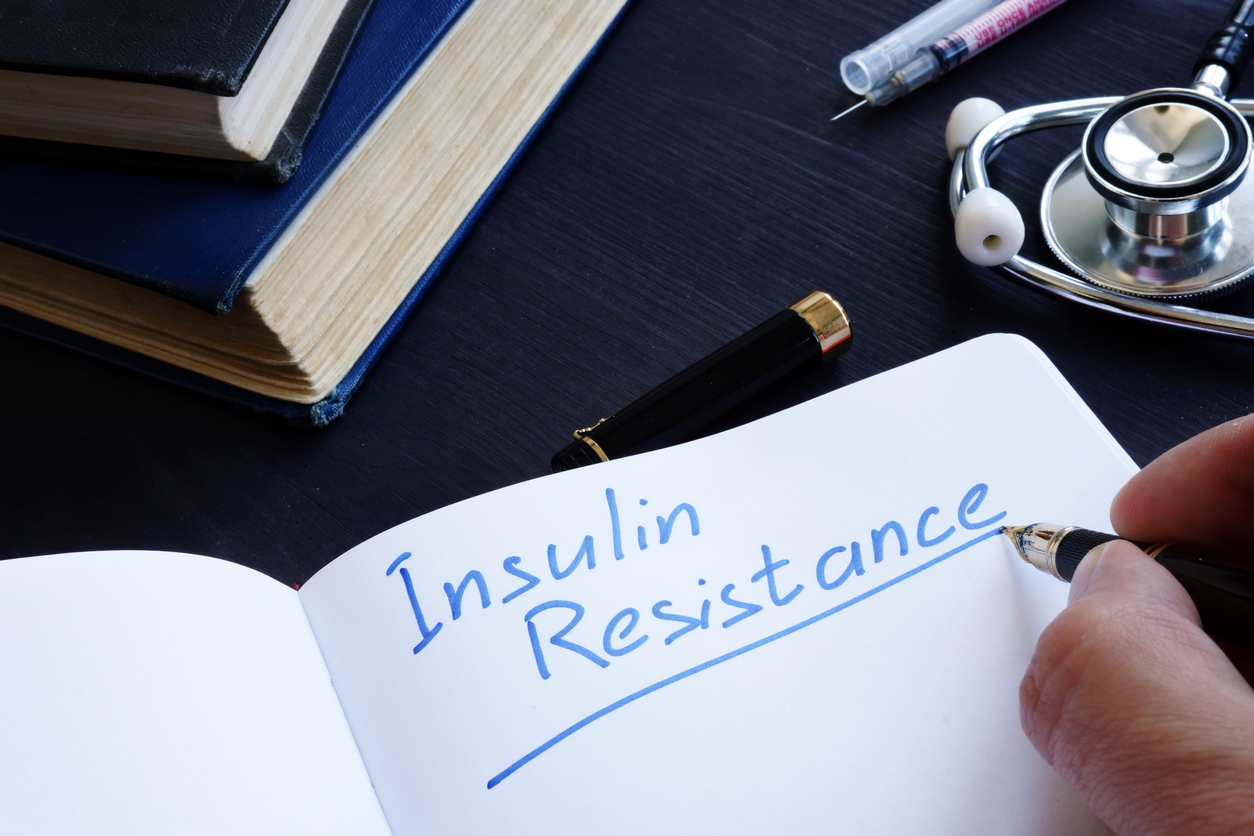
Insulin resistance takes place when the body produces insulin, but cannot use it efficiently. Muscle, liver, and/or fat cells don’t respond properly to insulin and have problems absorbing glucose from the bloodstream, causing glucose to build up in the bloodstream instead of being absorbed into the cells. As a result, the body requires more insulin to upload glucose into the cells, so the beta cells in the pancreas have to produce more insulin to keep up.
Over time, insulin resistance can lead to metabolic syndrome with progressive symptoms of high blood pressure and sugar levels. It can also lead to excessive visceral fat, as well as abnormal cholesterol levels, which can increase the risk of LDL or VLDL oxidation, tearing up the arteries and other organs (like the kidneys). Now you’re at risk for obesity, heart disease, stroke, pre-diabetes and type 2 diabetes, as beta cells fail to keep up with the body’s demand for insulin.
Diabetes is a metabolic disease where blood sugar levels remain higher than normal, either because there is limited, or no production of insulin. Diabetes can result from autoimmune destruction of insulin producing beta cells like in type 1 – insulin dependent diabetics, or in type 2 diabetes, where the cells do not respond or fail to utilize the insulin produced. Eventually, the beta cells can lose function and you produce less of them. As insulin levels decrease most will require blood glucose-lowering medications and/or insulin injections (if treated conventionally). It can also occur temporarily during pregnancy, as seen in the development of gestational diabetes.
Diabetes is diagnosed if fasting blood glucose levels are higher than 126 mg/dL two times in a row, or if glucose levels are higher than 200 mg/dL 2 hours after having a certain sugary drink administered by a practitioner. Those with the active condition experience increased thirst, as well as frequent urination and hunger, as the kidneys try to eliminate the buildup of blood sugar and acid waste. Frequent urination also increases loss of electrolytes which play a VERY important role in maintaining pH balance. Now that you have been introduced to this insidious disease, let’s find out the details of its origin, what’s involved, and how you can prevent it!
You never hear anyone speak about diabetes without including insulin, the primary hormone involved. Insulin, produced by the pancreas, manufactures pancreatic juice with an alkaline pH of 8.8, which happens to be one of the highest pH body fluids. This hormone, when released into the bloodstream, is ESSENTIAL for the regulation of fat, protein, and carbohydrate metabolism in the body. Its job is to help muscle, fat, liver, and red blood cells absorb glucose from the bloodstream. It plays a major role in glucose metabolism from the blood into the cells, and the redirection of extra energy into storage.
After a healthy individual consumes a meal, what’s not needed for immediate energy gets stored in the liver and muscles in the form of glycogen, with the assistance of insulin. In a healthy adult, the liver stores about 100-120 grams of glycogen and can be made available to the blood and other organs on demand. The amount of glycogen stored in muscle cells specifically depends on dietary habits, muscle mass, and metabolism. Any excess is converted by the liver and stored as triglycerides in fat cells (hopefully for later use).
Insulin is generally present during meals, but should subside between meals to allow for fat burning (as seen in healthy individuals with a normal insulin response. If an individual is insulin resistant and eats a normal-high intake of carbs, up to five times the amount of insulin is necessary to bring blood glucose back down to healthy levels. Some people produce so much insulin that their blood sugar levels dip way below normal when cells eventually absorb all the blood glucose, initiating a hypoglycemic reaction. In others, insulin levels in the blood remain high, like in that of unregulated or undiagnosed prediabetes or diabetes. At this point, weight gain is inevitable and weight loss becomes impossible.
In recent research, the American Diabetes Association estimates that the total costs of diagnosed diabetes have risen to $245 billion in from $174 billion in 2007. This figure represents a startling 41 percent increase over a five-year period! “As the number of people with diabetes grows, so does the economic burden it places on this country,” said Robert Ratner, MD, Chief Scientific & Medical Officer of the American Diabetes Association. “The cost of diabetes is rising at a rate higher than overall medical costs with more than one in 10 health care dollars in the country being spent directly on diabetes and its complications, and more than one in five health care dollars in the U.S. going to the care of people with diagnosed diabetes.”
Here are some more disturbing statistics:
- More than 80 percent of adults with Type 2 diabetes die from strokes or heart attacks, passing away at younger ages compared to those without diabetes.
- Diabetes is the seventh leading cause of death in the US and is the leading cause of kidney failure and blindness in older adults. Diabetes also increases cancer risk, especially colorectal cancer.
- Over 60,000 amputations are performed yearly due to complications of diabetes.
- Diabetes affects 26 million people of all ages (about 8.3% of the US population) and 95% of them are type 2 which is preventable! Of those, 80% are overweight or obese.
- A startling 80 million Americans over 20 years of age are pre-diabetic.
- About 215,000 of our precious children under 20 have diabetes type 1 or type 2 — this represents 26% of all people in this age group.
- 27 percent of senior Americans had diabetes in 2010.
- Estimates project that at least 1 in 3 Americans will have diabetes in 2050
https://www.cdc.gov/diabetes/basics/quick-facts.html
https://www.ncbi.nlm.nih.gov/pubmed/23468086
